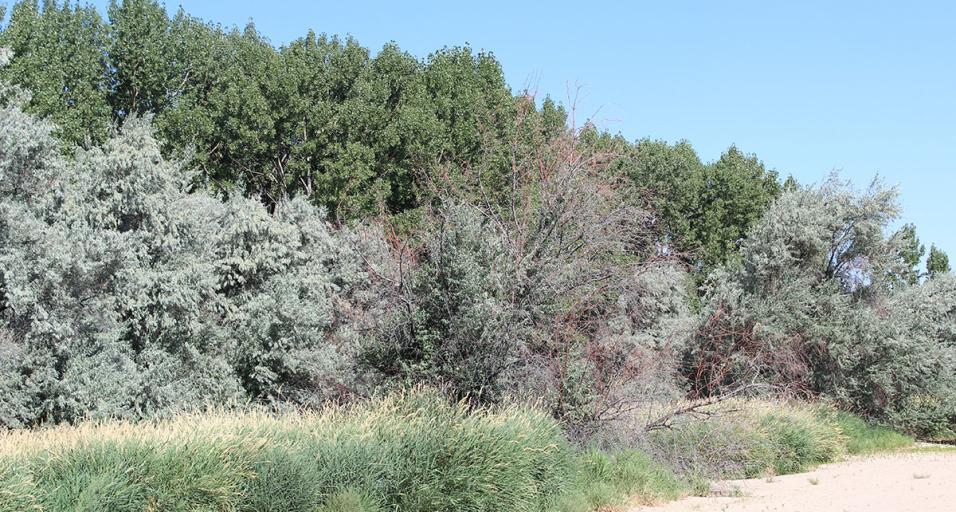Russian olive, Elaeagnus angustifolia, is a perennial that can grow up to 35 feet tall but often takes the form of a small shrubby tree. It has scaly bark and thorns. The leaves appear light green and silvery and are alternately attached to the stem. The fruit is berry-like and is yellow when immature but develops into a dark red color once mature. Russian olives become prolific in mesic habitats such as drainages, riparian areas, and wetlands. They can grow on a variety of soils but tend to favor coarser soils found on sandy and loamy sites. Russian olive is not poisonous and has some limited forage value. The leaves are not very palatable. Waterfowl and other wildlife species often eat the berries, but they are less digestible and have less energy than berries from native species.
Russian olive is listed as a noxious weed in Wyoming due to its ability to displace native vegetation such as buffaloberry, golden current, chokecherries, and cottonwood. Russian olives also grow much denser than native vegetation which can lead to declines in herbaceous vegetation communities as well. If Russian olive is removed while native species are still present, the area will typically recover without more intensive restoration efforts. If left untreated, vegetation species diversity, and correspondingly, wildlife species diversity will decrease.
Russian olive is controlled by mechanical and chemical treatments. Mechanical treatments such as mastication and cut stump allow for the top material to be removed. Herbicide is then either applied to the stump following treatment or to the re-growth. Herbicide treatments are most effective in the fall because the trees are pulling carbohydrates into their roots which will also allow for transport of the chemical into the root system.
Mastication is often an excellent method for reducing the sometimes unwieldy amount of Russian olive growth into mulch that breaks down over time. It is typically not feasible or effective to spray the stumps following mastication. The machines are dangerous to be near and by the time it is safe for an herbicide applicator to approach the stump, the effective application timeframe has passed and the stump has “sealed over”. Therefore, re-sprouting from this method is often extensive and will require many years of herbicide application. Cut stump treatments, where trees are cut with a chainsaw and then herbicide is immediately applied directly to the stump, results in less follow-up work. However, additional labor and costs may be associated with removal of the tree material. Russian olive removal work may involve some level of soil disturbance if heavy equipment is used, but it is typically not noticeable after about a year. Herbicide application can usually be applied precisely and usually does not result in incidental damage to desirable plants.
A recent example of a Russian olive removal project is the Dave Johnston Powerplant near Glenrock, WY. This area is a walk-in area for waterfowl hunting and fishing. The Russian olives were so thick in places that they couldn’t be walked through (see photo below). In collaboration with partners, the Department masticated the olives. The Converse County Weed & Pest district sprayed the re-growth for several years then the Department re-planted the area to native trees and shrubs this past fall.
----
By Willow Bish, Casper Region Wildlife Biologist
Russian Olive grow dense, decreasing native diversity
Wyoming Game and Fish (307) 777-4600

